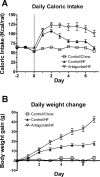Leptin resistance: a prediposing factor for diet-induced obesity
- PMID: 19091915
- PMCID: PMC2665845
- DOI: 10.1152/ajpregu.90669.2008
Leptin resistance: a prediposing factor for diet-induced obesity
Abstract
Obesity is a resilient and complex chronic disease. One potential causative factor in the obesity syndrome is leptin resistance. Leptin behaves as a potent anorexic and energy-enhancing hormone in most young or lean animals, but its effects are diminished or lacking in the obese state associated with a normal genetic background. Emerging evidence suggests that leptin resistance predisposes the animal to exacerbated diet-induced obesity (DIO). Elevation of central leptin in young, lean rats induces a leptin resistance that precludes obesity on a chow diet but accelerates high-fat (HF)-induced obesity. Similarly, chronic dietary fructose consumption evokes a leptin resistance that causes obesity only upon HF exposure. Inherent central leptin insensitivity also contributes to dietary weight gain in certain obesity-prone rats. Conversely, aged, leptin-resistant animals are obese with continuous chow feeding and demonstrate aggravated obesity when challenged with an HF diet. Additionally, a submaximal central blockade with a leptin antagonist leads to obesity on both chow and HF diets, as is the case in rodents with leptin receptor deficiency of genetic origin. Despite the differences in the incidence of obesity on a chow diet, all of these forms of leptin resistance predispose rodents to aggravated HF-mediated obesity. Moreover, once leptin resistance takes hold, it aggravates DIO, and the leptin resistance and obesity compound one another, promoting a vicious cycle of escalating weight gain.
Figures


Similar articles
-
Prolonged hyperphagia with high-fat feeding contributes to exacerbated weight gain in rats with adult-onset obesity.Am J Physiol Regul Integr Comp Physiol. 2008 Sep;295(3):R773-80. doi: 10.1152/ajpregu.00727.2007. Epub 2008 Jul 2. Am J Physiol Regul Integr Comp Physiol. 2008. PMID: 18596107 Free PMC article.
-
Modulation of central leptin sensitivity and energy balance in a rat model of diet-induced obesity.Diabetes Obes Metab. 2007 Nov;9(6):840-52. doi: 10.1111/j.1463-1326.2006.00653.x. Diabetes Obes Metab. 2007. PMID: 17924866
-
Influence of high-fat feeding, diet-induced obesity, and hyperamylinemia on the sensitivity to acute amylin.Physiol Behav. 2011 Jul 25;104(1):20-8. doi: 10.1016/j.physbeh.2011.04.044. Epub 2011 May 3. Physiol Behav. 2011. PMID: 21550355
-
Is leptin resistance the cause or the consequence of diet-induced obesity?Int J Obes (Lond). 2018 Aug;42(8):1445-1457. doi: 10.1038/s41366-018-0111-4. Epub 2018 May 22. Int J Obes (Lond). 2018. PMID: 29789721
-
Elevated leptin: consequence or cause of obesity?Front Biosci. 2007 May 1;12:3531-44. doi: 10.2741/2332. Front Biosci. 2007. PMID: 17485319 Review.
Cited by
-
Carotid Body and Metabolic Syndrome: Mechanisms and Potential Therapeutic Targets.Int J Mol Sci. 2020 Jul 20;21(14):5117. doi: 10.3390/ijms21145117. Int J Mol Sci. 2020. PMID: 32698380 Free PMC article. Review.
-
Treadmill Intervention Attenuates the Cafeteria Diet-Induced Impairment of Stress-Coping Strategies in Young Adult Female Rats.PLoS One. 2016 Apr 21;11(4):e0153687. doi: 10.1371/journal.pone.0153687. eCollection 2016. PLoS One. 2016. PMID: 27099927 Free PMC article.
-
Deep brain stimulation for obesity--from theoretical foundations to designing the first human pilot study.Neurosurg Rev. 2012 Jan;35(1):37-42; discussion 42-3. doi: 10.1007/s10143-011-0359-9. Epub 2011 Oct 15. Neurosurg Rev. 2012. PMID: 21996938 Review.
-
Dietary intakes and leptin concentrations.ARYA Atheroscler. 2014 Sep;10(5):266-72. ARYA Atheroscler. 2014. PMID: 25477984 Free PMC article. Review.
-
Expression of leptin receptor in renal tubules is sparse but implicated in leptin-dependent kidney gene expression and function.Am J Physiol Renal Physiol. 2023 Jun 1;324(6):F544-F557. doi: 10.1152/ajprenal.00279.2022. Epub 2023 Apr 27. Am J Physiol Renal Physiol. 2023. PMID: 37102688 Free PMC article.
References
-
- Attig L, Solomon G, Ferezou J, Abdennebi-Najar L, Taouis M, Gertler A, Djiane J. Early postnatal leptin blockage leads to a long-term leptin resistance and susceptibility to diet-induced obesity in rats. Int J Obes (Lond) 32: 1153–1160, 2008. - PubMed
-
- Augustine RA, Grattan DR. Induction of central leptin resistance in hyperphagic pseudopregnant rats by chronic prolactin infusion. Endocrinology 149: 1049–1055, 2008. - PubMed
-
- Banks WA, Coon AB, Robinson SM, Moinuddin A, Shultz JM, Nakaoke R, Morley JE. Triglycerides induce leptin resistance at the blood-brain barrier. Diabetes 53: 1253–1260, 2004. - PubMed
-
- Banks WA, Farrell CL. Impaired transport of leptin across the blood-brain barrier in obesity is acquired and reversible. Am J Physiol Endocrinol Metab 285: E10–E15, 2003. - PubMed
-
- Bayol SA, Farrington SJ, Stickland NC. A maternal “junk food” diet in pregnancy and lactation promotes an exacerbated taste for “junk food” and a greater propensity for obesity in rat offspring. Br J Nutr 98: 843–851, 2007. - PubMed
Publication types
MeSH terms
Substances
LinkOut - more resources
Full Text Sources
Other Literature Sources
Medical
Research Materials
Miscellaneous

